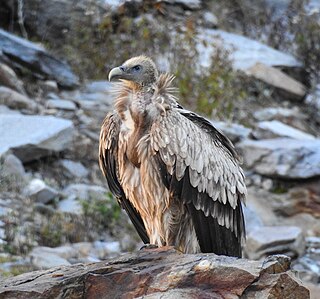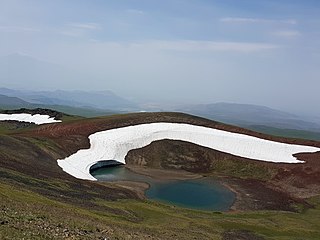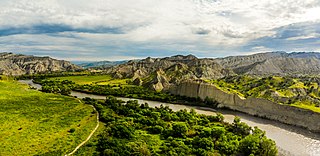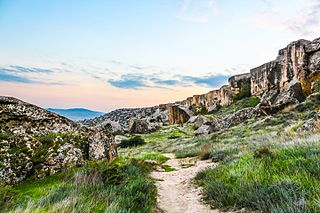
A vulture is a bird of prey that scavenges on carrion. There are 23 extant species of vulture. Old World vultures include 16 living species native to Europe, Africa, and Asia; New World vultures are restricted to North and South America and consist of seven identified species, all belonging to the Cathartidae family. A particular characteristic of many vultures is a bald, unfeathered head. This bare skin is thought to keep the head clean when feeding, and also plays an important role in thermoregulation.

The Himalayan vulture or Himalayan griffon vulture is an Old World vulture native to the Himalayas and the adjoining Tibetan Plateau. It is one of the two largest Old World vultures and true raptors. It is listed as Near Threatened on the IUCN Red List. It is not to be confused with the griffon vulture, which is a similar species.

The hooded vulture is an Old World vulture in the order Accipitriformes, which also includes eagles, kites, buzzards and hawks. It is the only member of the genus Necrosyrtes, which is sister to the larger Gyps genus, both of which are a part of the Aegypiinae subfamily of Old World vultures. It is native to sub-Saharan Africa, where it has a widespread distribution with populations in southern, East and West Africa. It is a scruffy-looking, small vulture with dark brown plumage, a long thin bill, bare crown, face and fore-neck, and a downy nape and hind-neck. Its face is usually a light red colour. It typically scavenges on carcasses of wildlife and domestic animals. Although it remains a common species with a stable population in the lower region of Casamance, some areas of The Gambia, and Guinea-Bissau, other regions such as Dakar, Senegal, show more than 85% losses in population over the last 50 years. Threats include poisoning, hunting, loss of habitat and collisions with electricity infrastructure, and the International Union for Conservation of Nature has rated its conservation status as "critically endangered" in their latest assessment (2017). The highest current regional density of hooded vultures is in the western region of The Gambia.

The cinereous vulture is a large raptor in the family Accipitridae and distributed through much of temperate Eurasia. It is also known as the black vulture, monk vulture and Eurasian black vulture. With a body length of 1.2 m, 3.1 m (10 ft) across the wings and a maximum weight of 14 kg (31 lb), it is among the largest Old World vultures.

Aegypius is a genus of Old World vultures found in the subfamily Gypinae. Of the three species in the genus, only the cinereous vulture is extant. The Cinerous vulture is a creature that is hard to find as it is “a near threatened raptor that occurs in isolated populations across its range” (Çakmak). There were studies being conducted on the cinerous vulture and it indicates “that the Turkish birds hold, along with those from the Caucasus, an intermediate position between European and North Asian (Mongolian) lineages” (Çakmak). The genus name Aegypius is a Greek word (αἰγυπιός) for 'vulture', or a bird not unlike one; Aelian describes the aegypius as "halfway between a vulture (gyps) and an eagle". Some authorities think this a good description of a lammergeier; others do not. Aegypius is the eponym of the species, whatever it was.

The East Saharan montane xeric woodlands is an ecoregion of central Africa, a number of high mountains in the middle of the huge area of savanna on the edge of the Sahara Desert.
The Alicyclobacillaceae are a family of Gram-positive bacteria. All members of this family are aerobic and form endospores.

The Sierra de Gredos is a mountain range in central Spain that spans the provinces of Ávila, Salamanca, Cáceres, Madrid, and Toledo. It is part of the much larger Sistema Central of mountain ranges. Its highest point is Pico Almanzor, at 2,592 metres and it has been declared a natural park by the Autonomous Community of Castile and León. The Sierra de Gredos is one of the most extensive mountain ranges of the Central System; it comprises five river valleys: the Alto Tormes, the Alto Alberche, the Tiétar Oriental, the Tiétar Occidental y la Vera, and the Valle del Ambroz. The first known inhabitants were the Vettones, a pre-Roman Celtic people. The central part of the range encomprises the Sierra de Gredos Regional Park.

The Krumovitsa is a river in the eastern Rhodope Mountains of Bulgaria. The river valley is formed by the Krumovitsa River and the Djushun River together with the surrounding low mountain slopes.

El Tiemblo is a municipality located in the province of Ávila, Castile and León, Spain. According to the 2012 census (INE), the municipality has a population of 4,461 inhabitants, and covers an area of about 75 km2.
Cinereous is a colour, meaning ashy grey in appearance, either consisting of or resembling ashes, or a grey colour tinged with coppery brown. It is derived from the Latin cinereus, from cinis (ashes).

Indawgyi Lake Wildlife Sanctuary is a biosphere reserve in Myanmar, covering 814.99 km2 (314.67 sq mi). It ranges in elevation from 105–1,400 m (344–4,593 ft) encompassing the surroundings of Indawgyi Lake in Mohnyin Township, Kachin State. It was gazetted in 2004, is recognized as an Important Bird Area and as one of the ASEAN Heritage Parks. An area of 478.84 km2 (184.88 sq mi) comprising the lake and the surrounding lowland is a Ramsar site since February 2016.

Azhdahak is a volcano in Armenia, the highest point of Gegham mountains. It has an elevation of 3,597 m above sea. It is part of the Ghegam Ridge volcanic field, which last erupted at 1900 BC ± 1000 years.

Vashlovani Strict Nature Reserve is a protected area in Dedoplistsqaro Municipality, Kakheti region of Georgia on Shiraqi mountain range and Georgian bank of Alazani River, at elevation 300-600 meters above sea level.
Oceanisphaera avium is a Gram-negative and aerobic bacterium from the genus of Oceanisphaera which has been isolated from the gut of the raptorial bird Aegypius monachus from the Seoul Grand Park Zoo in South Korea.
Tumebacillus is a genus of Gram-positive, rod-shaped, spore-forming bacteria. Members of the genus can be motile or non-motile, and form white or yellow colonies on R2A agar.
Tumebacillus avium is a species of Gram positive, facultatively aerobic, bacterium. The cells are rod-shaped, motile, and form spores. It was first isolated from faecal sample of a cinereous vulture from the Seoul Grand Park Zoo, Seoul, South Korea. The species was first described in 2018, and the name is derived from Latin avium.

The Ghorat-Hazarajat alpine meadow ecoregion covers the high mountainous elevations of central Afghanistan. The ecoregion fans out to the west from the capital city of Kabul at the eastern point. Vegetation is thornbush meadows and alpine grassland. The region is the home of the critically endangered Afghan brook salamander, which depends on the cold waters of the high streams of the ecoregion.

The Azerbaijan shrub desert and steppe is a deserts and xeric shrublands ecoregion in western Asia. It lies in the lowlands west of the Caspian Sea, and covers portions of Azerbaijan, Georgia, and Iran.
Boudabousia liubingyangii is a Gram-positive and non-spore-forming bacterium from the genus of Boudabousia which has been isolated from rectal swabs of the vultures Gypaetus barbatus.













